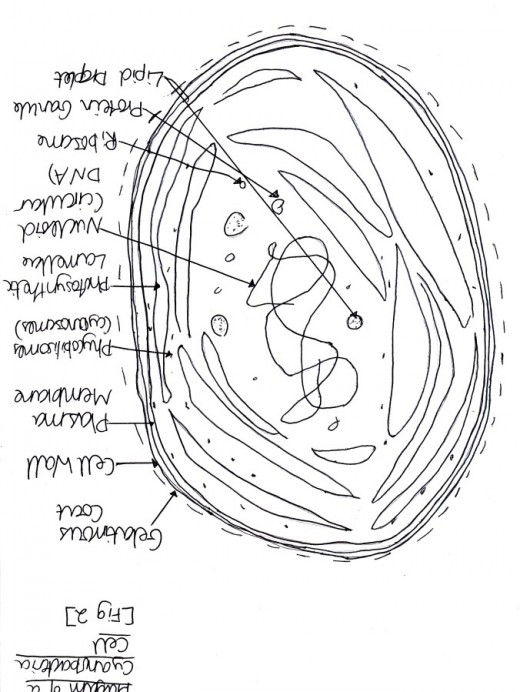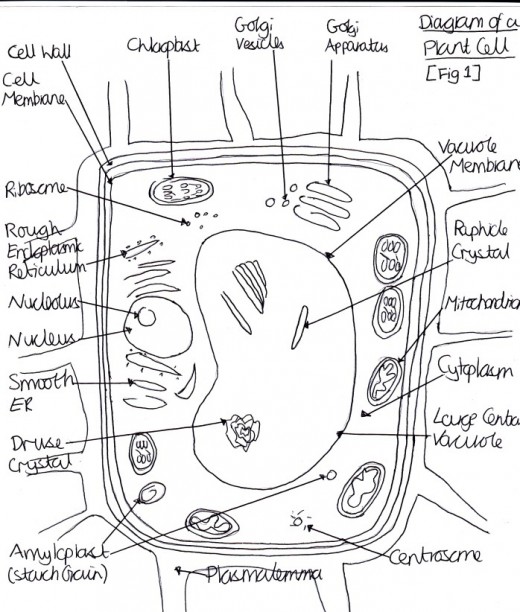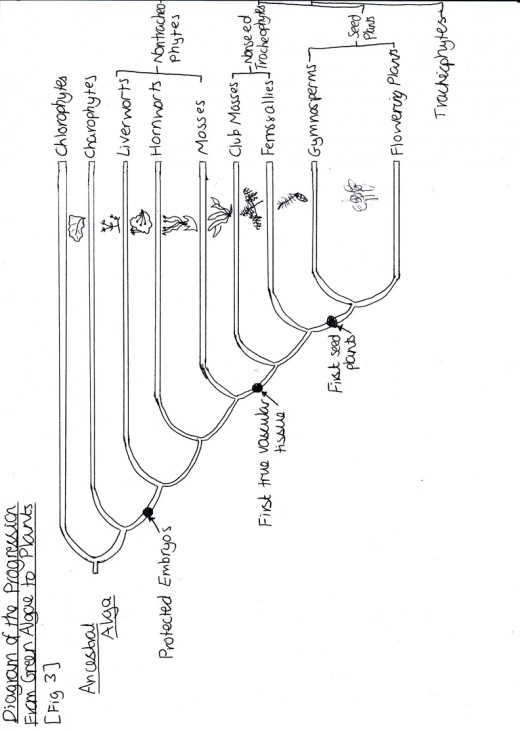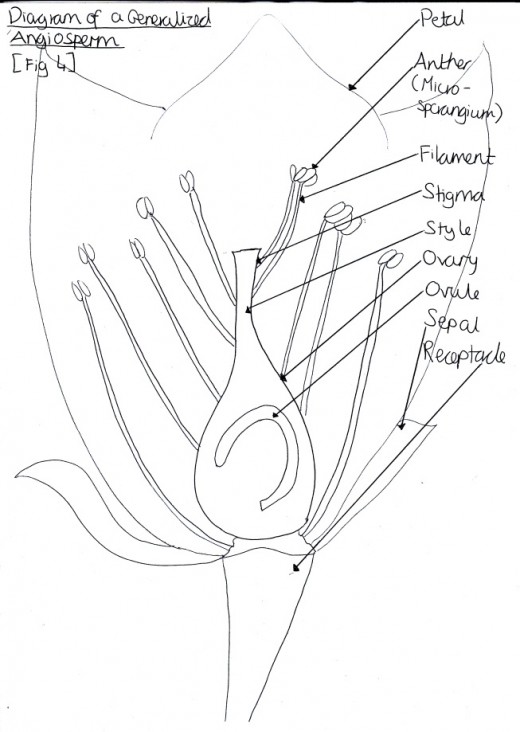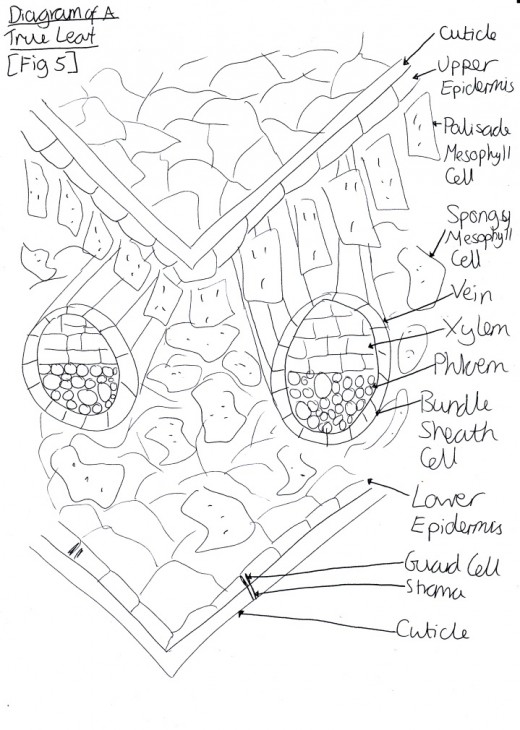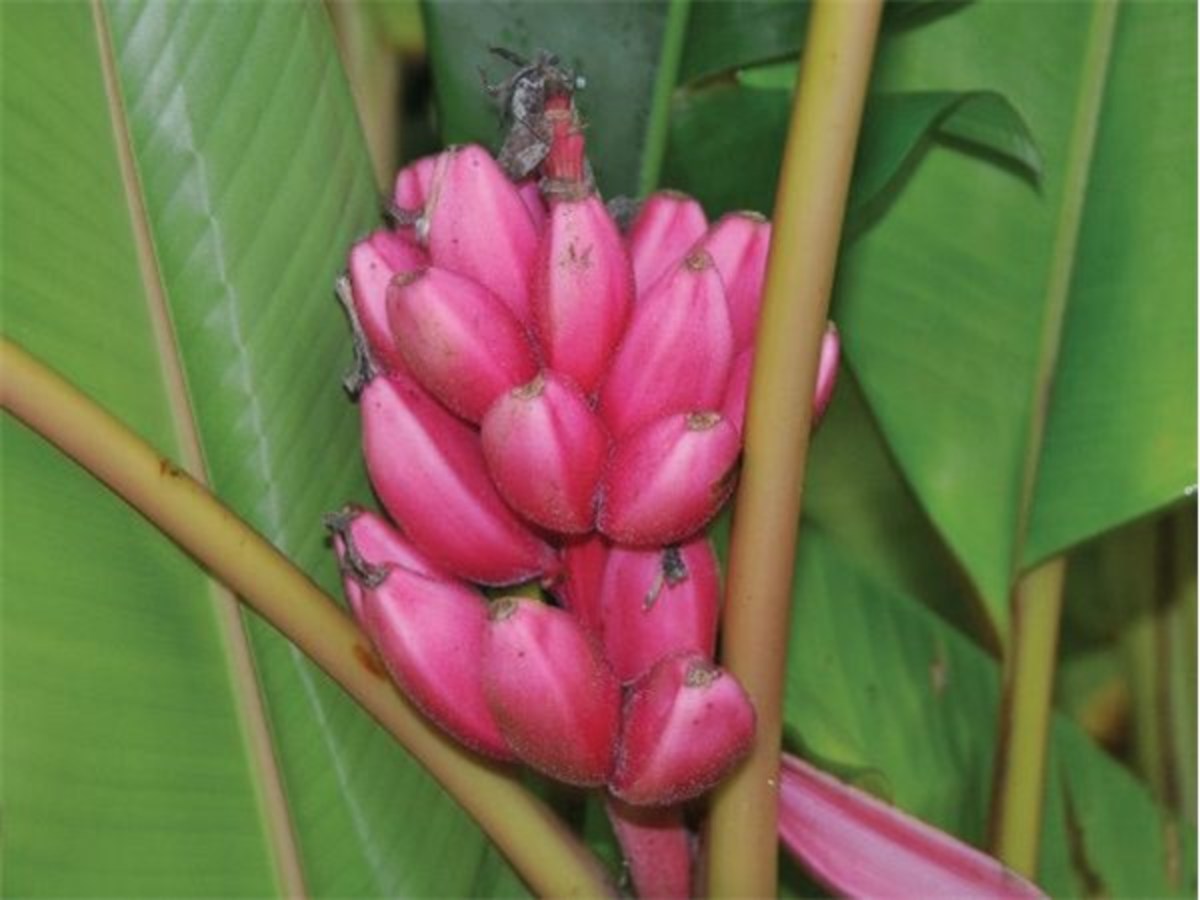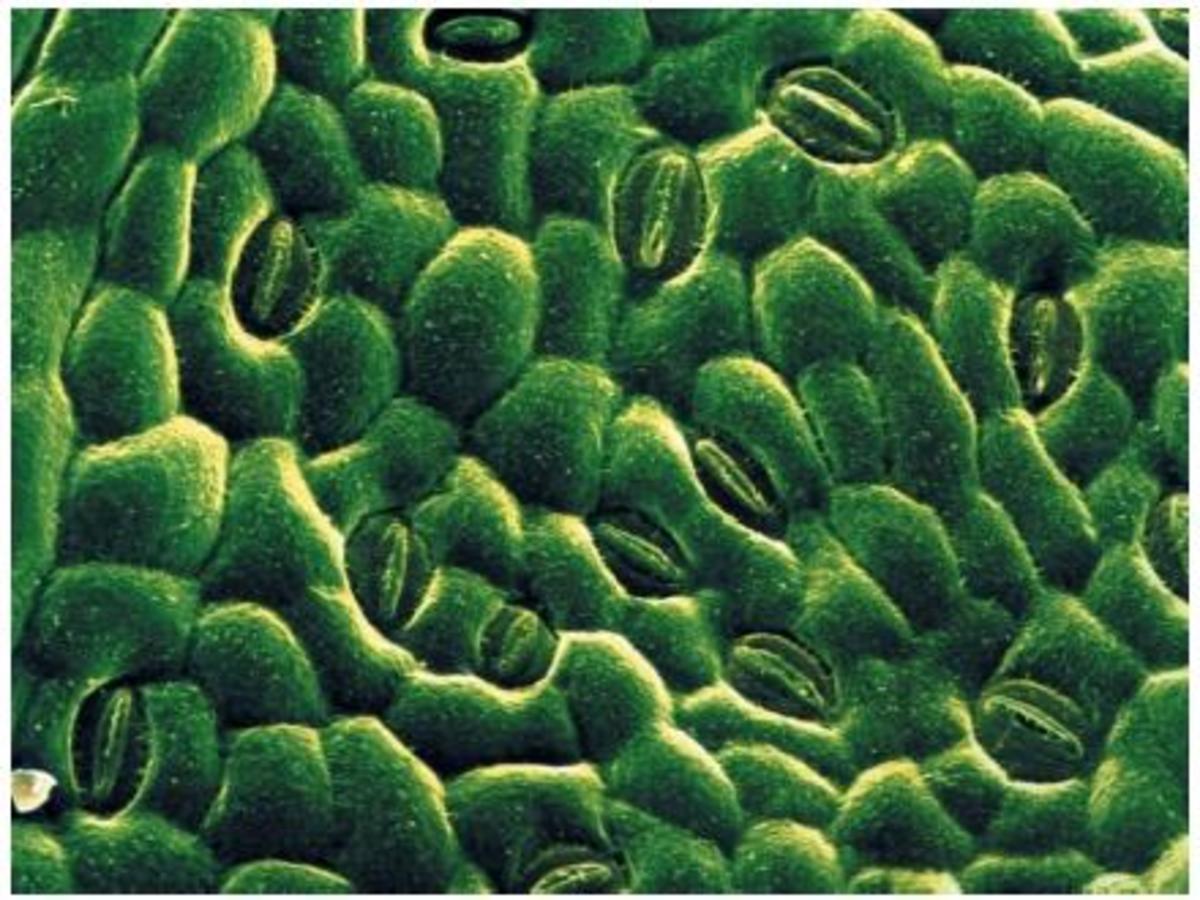How Eukaryotic Plants Colonised the Land
Figure 1 Diagram of a Cyanobacteria Cell
Click thumbnail to view full-size
Figure 2 Diagram of a Plant Cell
Click thumbnail to view full-size
Figure 3 Diagram of the Progression from Green Algae to Plants
Click thumbnail to view full-size
Figure 4 Diagram of a Generalised Angiosperm
Click thumbnail to view full-size

Life first began on Earth 3.5 billion years ago and since then it-and more importantly-the organisms it contains, have greatly changed. This gradual evolution is due to natural selection because between each generation there are variations, e.g. through mutation, and those organisms with the favourable allele for their particular environment, were more likely to survive to reproduction age and so pass on their characteristics (Purves et al 2004). The organisms of particular interest, however, are that of the eukaryotic plants and how they came to be [Figure 3].
The evolution of plants began 2700-3000 million years ago, when photosynthetic bacteria (e.g. cyanobacteria) developed. Metcalf and Codd (2004) describe it as having “a simple structure at subcellular level and lack a nucleus, a characteristic feature defining them, along with bacteria, as prokaryotes” [Figure 1]. It was considered to be the first step for eukaryotic plants, even though it is not one itself, because 1850 million years ago this simple aquatic algae formed the chloroplasts of plants today. Cyanobacteria was very successful because of its ability to do photosynthesis. This is when water is utilised as an electron donor and carbon dioxide is taken up and then converted, using energy from the sun, into oxygen (a bi-product) and sugars-the same way it is still done today by chloroplasts within plants [Figure 2]. Over time, a few prokaryotic cells became large enough to become predators of the smaller, by attacking, engulfing and ingesting them. However, as endosymbiosis theory suggests, some of these smaller prokaryotes survived, leaving them still functioning within the other organisms (Gault and Marler (2009)). Thus, they provided sugars to the larger organism and received nutrients and CO2 in return, which slowly evolved into the chloroplasts of today.
More complex multicellular organisms and complex Bryophytes, e.g. mosses and liverwort, evolved from green algae 500-300 million years ago and went on to colonise the land. 500 million years ago there were simple algae such as diatoms, dinoflagellates and euclenoids when before 300 million years ago there were more complex multicellular algae e.g. seaweeds like kelps, porphyra and Ulva. Green algae developed into these small plants able to live in damp areas by natural selection-the offspring who had favourable characteristics for an environment with less water in were more likely to serve to reproduction age and reproduce to pass on these characteristics. Purves (2004) agrees, saying “prokaryotes evolved the ability to transform themselves from rapidly growing cells into resting spores that could survive harsh environmental conditions” [Figure 1]. Also, cells were able to stick together after division and so they could act in a coordinated way, which then meant they were able to specialise. An example of such specialisation is that of having leaf-like structures (not true leaves), phyllids, that can catch and hold water when it splashes onto them. The bryophytes were also able to be further away from water by having embryos and gametes in a protective jacket made out of cells. They acquired the traits necessary for life on land. The first of which being a waxy cuticle which some of the bryophytes had to protect against bacterial attack and desiccation, meaning they can survive further away from water than previous organisms, even though they have no water-conducting tissues. In addition, they are small enough to allow diffusion to occur to allow the transport of minerals around their bodies, while water moves through capillary action, since they are not vascular plants, and enters directly into the plant via the epidermis. However they are and were not fully land plants because they lack several more of the requirements for life on land. They do not have roots for the uptake of nutrients and water. Also, without a vascular system they were restricted in height because they lack their support and diffusion is quite a slow process so nutrients take longer to distribute throughout the body. Another required trait is that of stomata, which are apertures in their phyllids that can be opened for air and shut to conserve water. Lastly strong ‘wood’ produced by secondary growth for strength was needed. Thus, the bryophytes needed to be by a large supply of water and be in the shade, e.g. the PHS of mosses is only at 4-20% full sunlight. Regardless of these setbacks, these were very important plants. 500 million years ago because of the photosynthesis from these plants producing oxygen as a bi-product, the ozone layer and stratosphere were formed, which absorbed UV light, allowing larger animals and plankton to survive.
However the vascular plants and gymnosperms, e.g. conifers, lycopods and ferns, had all of the requirements for life on land, which is why they became dominant 300 million years ago. The small plants, Bryophytes, become larger and more complex by slowly accumulating advantageous traits, making them even more adapted to their life on land. They gained true leaves, optimising photosynthesis [Figure 5]. They acquired efficient fluid-conducting systems, consisting of xylem and phloem, to improve water and food transport throughout the plant body. They also gained the ability to synthesize lignin (a plant polymer), which is used in the cell wall and adds to their rigidity, making it possible for vascularized plants to reach great heights. In addition, they had roots to absorb nutrients and water while also providing stability, instead of the rhizoids which bryophytes had that only provided stability. A further change was that the saprophyte phase or reproduction became the dominant, rather than the gametophytic stage which required water for fertilization. Another difference is that in vascular plants, the principal generation phase is the sporophyte, which is usually diploid with two sets of chromosomes per cell rather than gametophyte, which are haploid with one set of chromosomes per cell (Ridge (2002)). The seed-producing vascular plants e.g. conifers (not the seedless vascular plants e.g. lycopods and ferns), have seeds which are created when pollen (male gametophyte) is transferred via wind to the ovule (female gametophyte), where the seed then develops. The ability to be so well suited to land enabled them to dominate large areas because they were no longer dependant on large bodies of water and could instead survive from water in the soil e.g. from rain.
Regardless of how successful the vascular plants and angiosperms were, over time they too became usurped 65 million years ago when the angiosperms became the dominant species. This is because they were able to fill more niches and withstand greater extremes of temperature. Their reproductive organs are flowers, which contain an ovary that can develop into a fruit and aids with seed dispersal and an oval which is a megasporangiu that nourishes the female gametophyte within a protective integument so it is more likely to survive [Figure 4]. They also utilise insects for transfer of pollen by using attractive scents, shapes and colours and ‘rewarding’ insects with nectar. The pollen grains are also smaller, meaning that it takes less time for pollination and fertilisation e.g. in gymnosperms fertilisation can take a year after pollination. They are less likely to self-fertilise than those of the gymnosperm because the stamens have been modified. Futhermore, vessel elements, became shorter and wider than in gymnosperms and allowed for more efficient water transport (Purves et al (2004)). Megaphylls (true leaves) also became more diverse and specialized. Thus, they were able to colonize almost every part of the world today, regardless of the extreme environments, because of these incredibly specialized adaptations.
To conclude, eukaryotic plants colonized the land very slowly, through evolution, mutation and natural selection. They are now at the pinnacle of their existence, with over 288000 species they are adapted to almost all environments on the planet. Because of this, I think they will not evolve further however they may evolve in an artificial way because of human interaction such as genetic engineering and then maybe new eukaryotic plants will colonize the land (Botany 2008).
Bibliography
Books
Purves et al (2004), Life the Science of Biology, Seventh Edition
Oxford Dictionary of Biology (2008), Sixth Edition, Oxford University Press
J Mauseth (2008), Botany: an introduction to plant biology, 4th edition, Jones and Bartlett
Gault and Marler (2009), Handbook on Cyanobacteria: Biochemistry, Biotechnology and Applications, Nova Science
Staley et al (2007), Microbial Life, 2nd edition, Sinauer Associates Inc
Ridge (2002), Plants, Oxford University Press
Stewart (1993), Paleobotany and the Evolution of Plants
Willis and McElwain (2002), The Evolution of Plants, OUP Oxford
Reports
Metcalf and Codd (2004), Cyanobacterial toxins in the water environment
Diamond (2002), Evolution, consequences and future of plant and animal domestication, Nature Journal
Articles
Kenrick et al (1997), The origin and early evolution of plants on land
Wiley-Blackwell (2009), How did flowering plants evolve to dominate Earth?, ScienceDaily
Journals
Ravenand Edwards (2000), Roots: evolutionary origins and biogeochemical significance
Websites
Prof. R. E. Taggart, The First Vasclar Land Plants, Michigan State University, http://taggart.glg.msu.edu/isb200/fland.htm
University of Waikato, Plant and Animal Evolution, http://sci.waikato.ac.nz/evolution/plantEvolution.shtml
Davidson (2005), Plant Cell Structure, http://micro.magnet.fsu.edu/cells/plantcell.html, Florida State University

